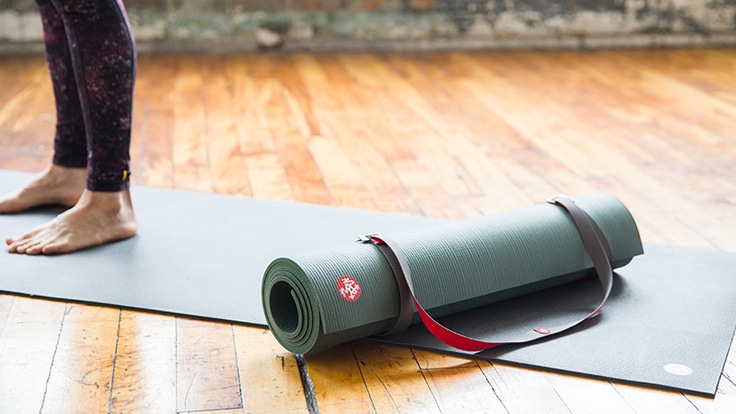Yoga mats are a near-perfect storm for harboring germs. When you practice, especially a more energetic style like power vinyasa or Bikram, you're likely to sweat a lot. And when that sweat drips onto your mat, it can lead to bacterial growth and unwanted odors. It's worth taking the time to wipe down your yoga mat briefly after every practice, as well as to give it a deep clean every month or so. Cleaning removes the buildup of dirt and sweat on your mat, which can keep your mat grippy and extend its life. In this article, we'll show you how to do it.
Why you need to clean your yoga mat
To help avoid germs and nasty mat smells, properly clean your mat on a regular basis. Cleaning your yoga mat is particularly important if you're practicing at a yoga studio where you share mats or props with others. The same rules still apply to your at-home practice, even if there's a lower risk of cross-contamination. Remember: Cleaning doesn't kill germs, but it does remove them, along with dirt and impurities, from a surface. To kill germs and help prevent the spread of infection, consider disinfecting your mat, as well. (Here's overall guidance from the EPA on disinfectant use.)
Yoga mat cleaning options
Some yoga mats are more porous than others; closed-cell mats are thinner and water resistant, and thus won't soak in liquid as quickly. Thicker yoga mats tend to have an open-cell construction, which means they can soak up more liquid and may retain more bacteria. Depending on the style of mat you have, there are a few different cleaning options.
How often should I clean my yoga mat? Wipe down your yoga mat briefly after every practice with a store-bought mat cleaner or a homemade cleaning solution. Once a month or so, give your yoga mat a deep cleaning to get rid of gunk that builds up over time. We'll go over the details below.
Can I wash my yoga mat in the washing machine? Some mats can be washed in a front-loading washing machine, but others will break down if washed this way. Check the care instructions for your specific mat.
For Routine Cleaning
Whether you have a thick mat or a thin one, it's a good idea to wipe down your mat after each practice. Consider using a DIY yoga mat cleaner after each practice, or a store-bought cleaner like Manduka's Mat Renew. Mixing your own cleaner is easy to do with products you likely have around the house.
Bring a bottle of cleaner and a clean towel to your practice. Spray the cleaner on your towel, then use circular motions to clean your mat's entire surface. Make sure to wipe both sides down before you roll up your mat at the end of practice.
Before you pick a cleaner, check your mat's care instructions. Some brands don't recommend vinegar-based solutions, for example, while others discourage high concentrations of essential oils.
For Deep Cleaning
You know it's time to give your mat a more thorough cleaning when you start to see more dirt and grime on it. Look for discolored, dirty spots. Yogis who live in warmer locations or frequently practice in heated rooms may also want to deep clean their mats more often.
If you have an open-cell mat, consider cleaning it each month by submerging your mat in soapy water. Thinner, closed-cell mats will break down when submerged in water, so spot clean those kinds of mats instead.
To deep clean an open-cell yoga mat:
- Put the mat in a sink or bathtub filled with warm water and dish soap. You don't need much soap—just 1 tablespoon for every gallon of water. (Avoid hot water, as it may damage the mat.)
- Submerge the mat in the water and allow it to soak for 5 minutes. Then lightly scrub it with a soft cloth.
- Rinse your mat with clean water to remove any soap residue.
- Once your mat is washed, shake it out. Then allow it to air dry for as long as it takes to be completely moisture-free.
To deep clean a closed-cell yoga mat:
- Lay your mat out on a flat surface.
- Mix warm water and a few drops of dish soap in a bowl. (Be careful not to add too much soap.)
Dip the rag into the soapy water, then clean the mat from top to bottom, prioritizing dirty spots, using a circular motion.
- Wipe the mat clean with a towel.
- Air dry for at least 30 minutes.
How to dry and store your yoga mat
Make sure your yoga mat is completely dry before putting it away. A warm, damp mat can be a breeding ground for bacteria. To dry completely, hang your mat over the back of a chair or over a porch railing. Never put your yoga mat in the dryer. Once the mat is dry, roll it up tightly and store in a place with good ventilation. Open the mat every few weeks, even if you're not using it, to allow air circulation.
If your mat starts peeling, or if pieces of it are sticking to your workout clothes, it's time to buy a new mat.
Related Articles
Article by Jenni Gritters. Jenni is a Seattle-based freelance journalist. You can find her bylines in the Guardian, Wirecutter, Outside magazine, 538, mindbodygreen and more. When Jenni isn't working with words, she's likely teaching yoga and mindfulness; hiking, camping and snowshoeing in the Pacific Northwest mountains; or running with her husband and puppy. She's been an REI member since 2017.
